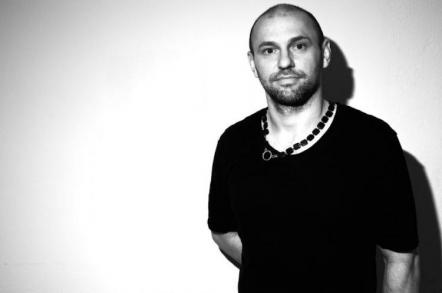New York, NY (Top40 Charts) "What's left of my music if I have it played by classical musicians and omit the most important element, the beats?" This question was the starting point for Instruments, the new album from Henrik Schwarz, the internationally celebrated producer, composer and performer of electronic dance music (EDM). Available April 14 via Sony Classical, the album features six acoustic chamber music arrangements of his electronic dance hits, plus an original composition.
Four years have passed now since the Berlin musician and producer was first invited to have a selection of his house tracks played by an orchestra. Now, the Tokyo Secret Orchestra has recorded seven pieces arranged for chamber orchestra that are reminiscent of the minimalism of Steve Reich and Michael Nyman.
The last ten years have seen quite a few classical performances of electronic club music. Many of these were in the "classic rock" tradition of the 1970's, when symphony orchestras played the pop hits of the day. "In most cases, electronic beats were then mixed into the orchestral arrangements, but I always found that a bit half-hearted," says Schwarz. He wasn't interested in so-called crossover; what interested him was what happens when club music is transferred to a body of classical instruments. "I wanted to see whether this music still means anything when you take away all the synthetic sounds and the beats." This prompted Schwarz to experiment with the scores, working together with arranger Johannes Brecht and various ensembles, without any computer sounds or acoustic percussion instruments that supply a rhythm in 4/4 time.
For more than a decade, Henrik Schwarz, 42, has been one of the best-respected house producers and a sought-after remixer working with artists like Steve Wonder, Mary J. Blige,
Ane Brun and Coldplay. In recent years, Schwarz has worked on a number of cross-genre projects: writing the music for a silent film, working with the Berlin
State Ballet and painter Norbert Bisky, recording with leading jazzmen Bugge Wesseltoft and Dan Berglund, and performing concerts with pianist Nik Bartsch. In addition, the arrangements on Instruments have been performed by different orchestras in some of Europe's best-known concert venues, such as Berlin's Kammermusiksaal, the Amsterdam Concertgebouw or the Tonhalle in Zurich.
The breakthrough came for Schwarz personally with a performance by 27 young Japanese musicians under conductor Emi Akiyama: they appeared in a Buddhist temple in 2013 under the name Tokyo Secret Orchestra. "Suddenly I heard my own music with different ears. Classical music makes completely different demands on the players from a house track. In house music it's the precision timing that creates the groove, but an orchestra is not used to playing like a machine. However, in Tokyo, I had the feeling that the musicians managed to penetrate to the music's core."
The recordings made in Japan supplied the source material for Instruments. Included are acoustic chamber music arrangements of Schwarz's EDM hits like the 2006 remix of "Wamims" and "Walk Music," which he has used as an opener for his live sets, plus one new composition "In Bjorndal."
All the pieces have been arranged for a complete body of strings (violins, violas, cellos and double bass). The strings are joined by low woodwind (bass flute, bass clarinet and bassoon), which not only supply individual timbres, but are also a source of rhythm like a vibraphone, a percussion instrument that is also a part of the new arrangements. In this context, the focus is on the magic and the magnetic power of minimalism, something that American composer Steve Reich used to influence the pop and techno scene with his cleverly interlocking rhythmic chains.
Right at the outset of "Walk Music," there is a magical combination of single, lyrical notes from the strings and mysterious vibraphone figures in the background. The following track, "Marvin," literally sprouts from a single note that is constantly repeated. Here, the bass flute, the viola and the cello evolve a rhythmic energy whose slightly burlesque tone is initially reminiscent of the neo-classicism of Stravinsky - at least until the orchestra strikes up a groove in several parts.
Nor is this by any means the only reference to the great classical masters: inconspicuous reminiscences of this kind are cunningly sprinkled in at liberty. The piece "In Bjorndal" radiates a curious and seductive melancholy magic that could almost be a tribute to Arnold Schonberg and his prismatic style. For "Leave My Head Alone Brain Seven," arranger Johannes Brecht added to the ensemble a bassett horn, a member of the clarinet family that Mozart was particularly fond of. In "I Exist Because Of You" the cello sometimes plays the so-called 'Bartok pizzicati' that go back to the Hungarian composer: the cellist twangs the string and then lets it spring back against the fingerboard.
The harmonies and sounds of the original tracks are played here by the strings and also a number of woodwind instruments, among which the bass clarinet has the starring role. Time and time again, production techniques from electronic music such as loops or low-cuts are transformed into orchestral arrangements, with frequencies being muffled over the space of several bars (e.g. in "Leave My Head Alone Brain Seven"). The result is a new kind of music played on classical instruments. A music that doesn't deny its roots in the club world and could only be created on the computer; a music that manages to transport the energy of electronic dance music to the classical concert hall - with the bass drum only present in the listener's head.
Sony
Music Masterworks comprises Masterworks, Sony Classical, OKeh, Portrait, Masterworks Broadway and Flying Buddha imprints. For email updates and information please visit www.SonyMasterworks.com.
Track listing
1. Walk
Music Four
2. Marvin Two
3. Leave My Head Alone Brain Seven
4. In Bjorndal
5. Cloud Three
6. Wamims
7. I Exist Because of You Two



















